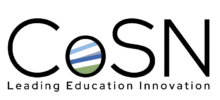Leading Education Technology Innovations: AI, Cybersecurity, and Student Well-Being
Watch the RecordingListen to the Podcast
This edLeader Panel is presented by CoSN and AASA.
Sponsored by ClassLink
Each year, CoSN conducts a national survey among education technology leaders to assess the current state of technology innovation across multiple school systems. Five specific current challenges were identified in the 2024 survey results: Artificial Intelligence (AI), Cybersecurity, Student Well-Being, Digital Equity, and Interoperability.
Three of the nation’s most innovative school superintendents shared how they tackle some of the most hotly contested tech topics and their best practices during the edLeader Panel “Leading Education Technology Innovations: Current Challenges and Solutions.”
Artificial Intelligence
More than one-third of the State of EdTech Leadership Survey respondents have started initiatives to investigate AI for use in schools, and 97 percent confirmed AI could benefit schools, according to Paula Maylahn, CoSN Project Director and author of CoSN’s annual EdTech Leadership Report since 2015.
There is “a lot of excitement around AI and how it can help our educators and our students,” said Dr. Avis Williams, the first woman permanently appointed as Superintendent of NOLA Public Schools (NOLA-PS) in New Orleans. NOLA-PS “rockstar” educators, lead teachers in the district, are helping explore teacher concerns and how AI may be used productively for things like test making.
Quakertown Community School District (PA) kicks off an AI taskforce this year, piloting it with 50 – 60 secondary teachers. They are considering day-to-day use of generative AI in lesson planning, research, and other supports, said Dr. Matthew Friedman, Superintendent of Schools.
All panelists mentioned the need to help students prepare for the world in which they live, and AI will be everywhere. Demystifying it and building bridges for constructive use is important.
Dr. Michael Nagler, Superintendent of Mineola Union Free School District (NY), said creating policies and getting a better understanding “starts with a common language.” For instance, is it complementary to tasks schools are already doing, embedded in partner products, and leveraged for class learning, or primarily a playground in which educators need a safe place to learn? Once districts understand how they are using the technology, they can better build a policy framework and identify ways to finance or vet products.
Cybersecurity
Cybersecurity remains a huge focal point. K–12 schools are increasingly targeted because the “information is so valuable to criminals,” said Maylahn. It’s a challenge; almost every survey respondent said their district was trying to improve protections.
Dr. Williams recommended schools consider the Council of Great City Schools for services and professional development. NOLA-PS includes more than 43,000 scholars across 68 schools. “Our biggest challenge is protecting student data . . . as a charter network, not all schools are on the same platforms or applications. So (we) need best practices when we know we have a variety of ways our schools are using technology.”
Mineola School District has been crippled in past ransomware attacks. Dr. Nagler said diligently educating staff is critical since the most common error tends to be user error—someone clicking on a nefarious link. Dr. Friedman noted focusing on digital citizenship helps, but it needs to be a continuous effort. “You have to be mindful at all times and can’t let your guard down. We have to give assurances to parents every day, and that’s a tall task,” he said.
Student Well-Being
According to Maylahn, “An overwhelming majority (93%) of districts are using technology solutions designed to address or improve student well-being, including tools monitoring and reporting bullying, self-harm, and tracking student behavior.” The impact of social media, school shootings, and other significant stressors have given rise to programs that support student mental health such as virtual therapists. Dr. Nagler said Gen Z are the most anxious and most in danger of having mental health issues. Unlike in earlier generations, information is ubiquitous, and it’s difficult to shield young minds.
All panelists agreed districts need to help students help themselves. New technologies can be helpful and make learning more efficient or personalize student learning. The more districts can embrace technology and prepare students for the challenges that come with it, the better equipped students will be for the world outside of the classroom.
Learn more about this edWeb broadcast, Leading Education Technology Innovations: Current Challenges and Solutions, presented by CoSN and AASA, and sponsored by ClassLink.
Watch the RecordingListen to the Podcast
Join the Community
Super-Connected is a free professional learning community for school superintendents, district leadership, and aspiring district leaders.


ClassLink is a global education provider of identity and analytics products that create more time for learning and help schools better understand digital engagement. As leading advocates for open data standards, we offer instant access to apps and files with single sign-on, streamline class rostering, automate account provisioning, and provide actionable analytics. ClassLink empowers 19 million students and staff in over 2,500 school systems. Visit classlink.com to learn more.
Article by Suzanne Bell, based on this edLeader Panel






Comments are closed.